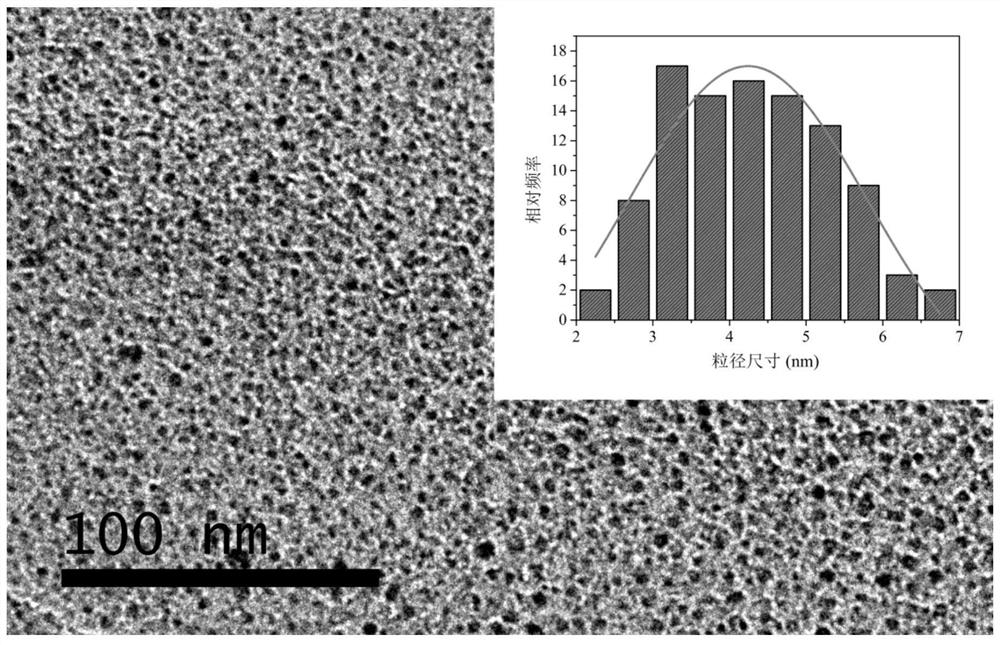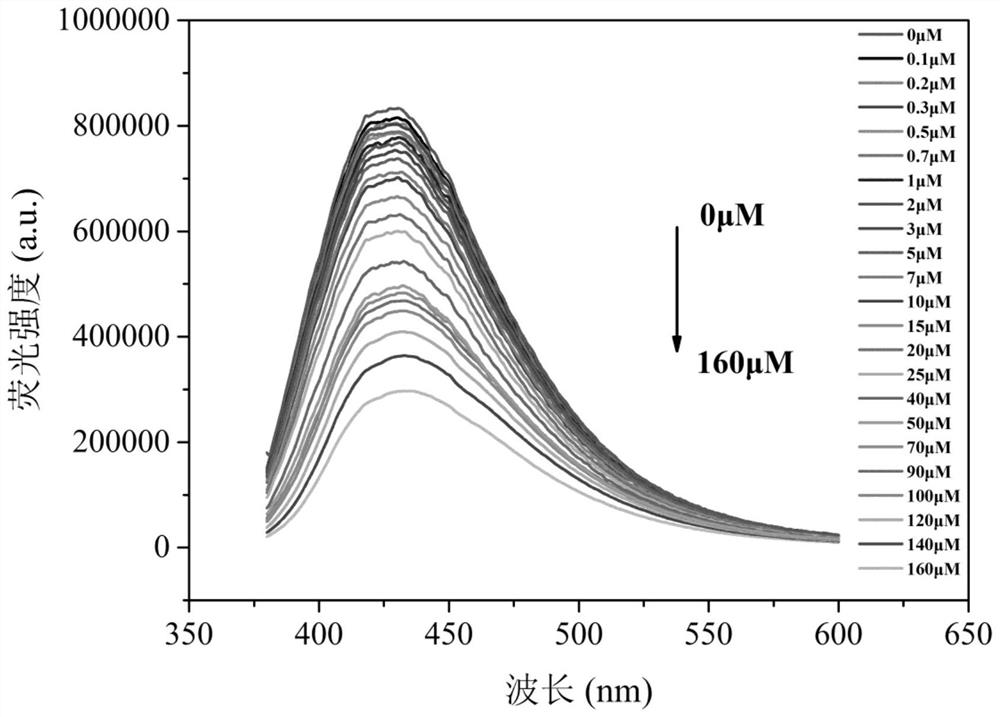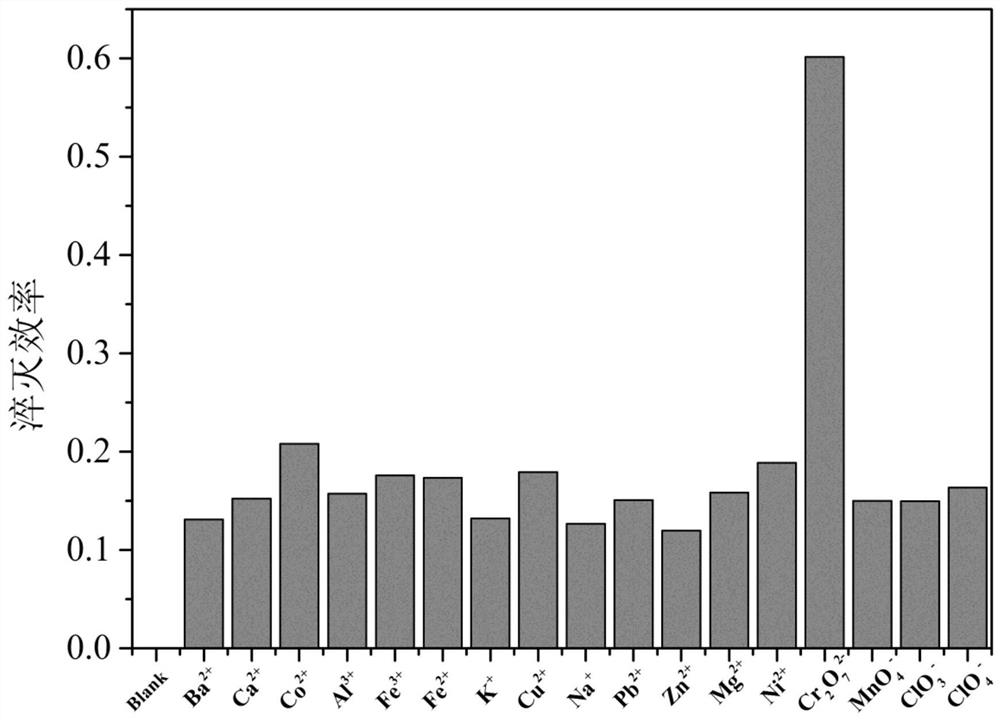Preparation method of carbon quantum dots and method for detecting dichromate with carbon quantum dots
A carbon quantum dot and dichromate technology, which is applied in the field of carbon quantum dot preparation, can solve the problems of cumbersome preparation of substances for detecting ions, less research on detection, and complicated methods.
- Summary
- Abstract
- Description
- Claims
- Application Information
AI Technical Summary
Problems solved by technology
Method used
Image
Examples
Embodiment 1
[0043] Use a pipette gun to add phosphoric acid into a 100ml beaker filled with deionized water to form an aqueous phosphoric acid solution, then add ethylenediamine to the above solution, and the molar ratio of phosphoric acid to ethylenediamine is 1:2. Stirring is then carried out at 80°C. A relatively violent reaction was carried out in an instant, and a large amount of white smoke was released during the reaction. Then, the beaker was placed on a magnetic stirrer, and the stirring was accelerated at 80°C to allow the reactants to fully react, and then transferred to a sealed polytetrafluoroethylene container. In the reaction kettle, put it into an oven and react under heating at 160°C for 8h. After cooling down to room temperature naturally, the obtained yellow-brown solution was passed through a 0.22 μM filter membrane, and the obtained filtrate was transferred to an ultrafiltration tube for centrifugation for 15 minutes to obtain the final clear solution in the tube. Th...
Embodiment 2
[0045] Use a pipette gun to add phosphoric acid to a 100ml beaker filled with deionized water to form a phosphoric acid aqueous solution, then use a pipette gun to add ethylenediamine to the above solution, the molar ratio of phosphoric acid to ethylenediamine is 1:4. Stirring is then carried out at 80°C. A relatively violent reaction was carried out in an instant, and a large amount of white smoke was released during the reaction. Then, the beaker was placed on a magnetic stirrer, and the stirring was accelerated at 80°C to allow the reactants to fully react, and then transferred to a sealed polytetrafluoroethylene container. In the reaction kettle, put it into an oven and react under heating at 140°C for 8h. After naturally cooling to room temperature, pass the obtained yellow-brown solution through a 0.22 μM filter membrane, transfer the obtained filtrate into an ultrafiltration tube and centrifuge for 30 min to obtain the final clear solution in the tube. The solution in ...
Embodiment 3
[0047] The present invention has also studied carbon quantum dots for different concentrations of Cr 2 o 7 2- detection situation.
[0048] (1) Adopt the carbon quantum dots of embodiment 1 to configure the carbon quantum dot solution, wherein the carbon quantum dot concentration is 0.3mg / ml.
[0049] (2) Configure Cr with a concentration of 0, 0.1, 0.2, 0.3, 0.5, 0.7, 1, 2, 3, 5, 7, 10, 15, 20, 25, 40, 50, 70, 90, 100, 120, 140, 160 μM 2 o 7 2- Solution, the above series of known concentrations of Cr 2 o 7 2- Solution is added in the carbon quantum dot solution that step (1) prepares, irradiates excitation light (excitation wavelength is 365nm), measures the change of its fluorescence intensity with Cr 2 o 7 2- Concentration variation (see figure 2 ), the results show that the fluorescence intensity increases with Cr 2 o 7 2- The concentration increases and decreases; according to the detected fluorescence intensity of the solution, the relationship between the...
PUM
| Property | Measurement | Unit |
|---|---|---|
| wavelength | aaaaa | aaaaa |
Abstract
Description
Claims
Application Information
 Login to View More
Login to View More - R&D
- Intellectual Property
- Life Sciences
- Materials
- Tech Scout
- Unparalleled Data Quality
- Higher Quality Content
- 60% Fewer Hallucinations
Browse by: Latest US Patents, China's latest patents, Technical Efficacy Thesaurus, Application Domain, Technology Topic, Popular Technical Reports.
© 2025 PatSnap. All rights reserved.Legal|Privacy policy|Modern Slavery Act Transparency Statement|Sitemap|About US| Contact US: help@patsnap.com



